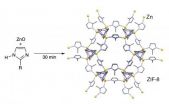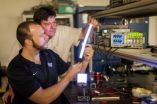(Press-News.org) Scientists have discovered for the first time how humans – and other mammals – have evolved to have intelligence.
Researchers have identified the moment in history when the genes that enabled us to think and reason evolved.
This point 500 million years ago provided our ability to learn complex skills, analyse situations and have flexibility in the way in which we think.
Professor Seth Grant, of the University of Edinburgh, who led the research, said: "One of the greatest scientific problems is to explain how intelligence and complex behaviours arose during evolution."
The research, which is detailed in two papers in Nature Neuroscience, also shows a direct link between the evolution of behaviour and the origins of brain diseases.
Scientists believe that the same genes that improved our mental capacity are also responsible for a number of brain disorders.
"This ground breaking work has implications for how we understand the emergence of psychiatric disorders and will offer new avenues for the development of new treatments," said John Williams, Head of Neuroscience and Mental Health at the Wellcome Trust, one of the study funders.
The study shows that intelligence in humans developed as the result of an increase in the number of brain genes in our evolutionary ancestors.
The researchers suggest that a simple invertebrate animal living in the sea 500 million years ago experienced a 'genetic accident', which resulted in extra copies of these genes being made.
This animal's descendants benefited from these extra genes, leading to behaviourally sophisticated vertebrates – including humans.
The research team studied the mental abilities of mice and humans, using comparative tasks that involved identifying objects on touch-screen computers.
Researchers then combined results of these behavioural tests with information from the genetic codes of various species to work out when different behaviours evolved.
They found that higher mental functions in humans and mice were controlled by the same genes.
The study also showed that when these genes were mutated or damaged, they impaired higher mental functions.
"Our work shows that the price of higher intelligence and more complex behaviours is more mental illness," said Professor Grant.
The researchers had previously shown that more than 100 childhood and adult brain diseases are caused by gene mutations.
"We can now apply genetics and behavioural testing to help patients with these diseases", said Dr Tim Bussey from Cambridge University, which was also involved in the study.
###
The study was funded by the Wellcome Trust, the Medical Research Council and European Union.
Origin of intelligence and mental illness linked to ancient genetic accident
Scientists have discovered for the first time how humans – and other mammals – have evolved to have intelligence
2012-12-03
ELSE PRESS RELEASES FROM THIS DATE:
Childhood trauma leaves mark on DNA of some victims
2012-12-03
This press release is available in German.
Abused children are at high risk of anxiety and mood disorders, as traumatic experience induces lasting changes to their gene regulation. Scientists from the Max Planck Institute of Psychiatry in Munich have now documented for the first time that genetic variants of the FKBP5 gene can influence epigenetic alterations in this gene induced by early trauma. In individuals with a genetic predisposition, trauma causes long-term changes in DNA methylation leading to a lasting dysregulation of the stress hormone system. As a result, ...
A shock to pollution in chemistry
2012-12-03
Solvents are omnipresent in the chemical industry, and are a major environmental and safety concern. Therefore the large interest in mechanochemistry: an energy-efficient alternative that avoids using bulk solvents and uses high-frequency milling to drive reactions. Milling is achieved by the intense impact of steel balls in a rapidly moving jar, which hinders the direct observation of underlying chemistry. Scientists have now for the first time studied a milling reaction in real time, using highly penetrating X-rays to observe the surprisingly rapid transformations as ...
Cell surface transporters exploited for cancer drug delivery
2012-12-03
CAMBRIDGE, Mass. (December 2, 2012) –Whitehead Institute scientists report that certain molecules present in high concentrations on the surfaces of many cancer cells could be exploited to funnel lethal toxic molecules into the malignant cells. In such an approach, the overexpression of specific transporters could be exploited to deliver toxic substances into cancer cells.
Although this finding emerges from the study of a single toxic molecule and the protein that it transports, Whitehead Member David Sabatini says this phenomenon could be leveraged more broadly.
"Our ...
Surprising results from study of non-epileptic seizures
2012-12-03
MAYWOOD, Il. - A Loyola University Medical Center neurologist is reporting surprising results of a study of patients who experience both epileptic and non-epileptic seizures.
Non-epileptic seizures resemble epileptic seizures, but are not accompanied by abnormal electrical discharges. Rather, these seizures are believed to be brought on by psychological stresses.
Dr. Diane Thomas reported that 15.7 percent of hospital patients who experienced non-epileptic seizures also had epileptic seizures during the same hospital stay. Previous studies found the percentage of such ...
A better way to make chemicals?
2012-12-03
Bulk solvents, widely used in the chemical industry, pose a serious threat to human health and the environment. As a result, there is growing interest in avoiding their use by relying on "mechanochemistry" – an energy-efficient alternative that uses high-frequency milling to drive reactions. Because milling involves the intense impact of steel balls in rapidly moving jars, however, the underlying chemistry is difficult to observe.
Now, for the first time, scientists have studied a milling reaction in real time, using highly penetrating X-rays to observe the surprisingly ...
Glowing fish shed light on metabolism
2012-12-03
A tiny, translucent zebrafish that glows green when its liver makes glucose has helped an international team of researchers identify a compound that regulates whole-body metabolism and appears to protect obese mice from signs of metabolic disorders.
Led by scientists at the University of California, San Francisco (UCSF), the work demonstrates how a fish smaller than a grain of rice can help screen for drugs to help control obesity, type 2 diabetes and other metabolic disorders, which affect a rising 34 percent of American adults and are major risk factors for cardiovascular ...
Stanford researchers discover master regulator of skin development
2012-12-03
STANFORD, Calif. — The surface of your skin, called the epidermis, is a complex mixture of many different cell types — each with a very specific job. The production, or differentiation, of such a sophisticated tissue requires an immense amount of coordination at the cellular level, and glitches in the process can have disastrous consequences. Now, researchers at the Stanford University School of Medicine have identified a master regulator of this differentiation process.
"Disorders of epidermal differentiation, from skin cancer to eczema, will affect roughly one-half ...
International study points to inflammation as a cause of plaque buildup in heart vessels
2012-12-03
STANFORD, Calif. — Fifteen new genetic regions associated with coronary artery disease have been identified by a large, international consortium of scientists — including researchers at the Stanford University School of Medicine — taking a significant step forward in understanding the root causes of this deadly disease. The new research brings the total number of validated genetic links with heart disease discovered through genome-wide association studies to 46.
Coronary artery disease is the process by which plaque builds up in the wall of heart vessels, eventually leading ...
Goodbye, fluorescent light bulbs! See your office in a new light
2012-12-03
Say goodbye to that annoying buzz created by overhead fluorescent light bulbs in your office. Scientists at Wake Forest University have developed a flicker-free, shatterproof alternative for large-scale lighting.
The lighting, based on field-induced polymer electroluminescent (FIPEL) technology, also gives off soft, white light – not the yellowish glint from fluorescents or bluish tinge from LEDs.
"People often complain that fluorescent lights bother their eyes, and the hum from the fluorescent tubes irritates anyone sitting at a desk underneath them," said David Carroll, ...
Common diabetes drug may help treat ovarian cancer
2012-12-03
A new study suggests that the common diabetes medication metformin may be considered for use in the prevention or treatment of ovarian cancer. Published early online in CANCER, a peer-reviewed journal of the American Cancer Society, the study found that ovarian cancer patients who took the drug tended to live longer than patients who did not take it.
New treatments are desperately needed for ovarian cancer. Previous research has indicated that metformin, which originates from the French Lilac plant, may have anticancer properties. To look for an effect of the medication ...
LAST 30 PRESS RELEASES:
B cells transiently unlock their plasticity, risking lymphoma development
Advanced AI dodel predicts spoken language outcomes in deaf children after cochlear implants
Multimodal imaging-based cerebral blood flow prediction model development in simulated microgravity
Accelerated streaming subgraph matching framework is faster, more robust, and scalable
Gestational diabetes rose every year in the US since 2016
OHSU researchers find breast cancer drug boosts leukemia treatment
Fear and medical misinformation regarding risk of progression or recurrence among patients with breast cancer
Glucagonlike peptide-1 receptor agonists and asthma risk in adolescents with obesity
Reviving dormant immunity: Millimeter waves reprogram the immunosuppressive microenvironment to potentiate immunotherapy without obvious side effects
Safety decision-making for autonomous vehicles integrating passenger physiological states by fNIRS
Fires could emit more air pollution than previously estimated
A new way to map how cells choose their fate
Numbers in our sights affect how we perceive space
SIMJ announces global collaborative book project in commemoration of its 75th anniversary
Air pollution exposure and birth weight
Obstructive sleep apnea risk and mental health conditions among older adults
How talking slows eye movements behind the wheel
The Ceramic Society of Japan’s Oxoate Ceramics Research Association launches new international book project
Heart-brain connection: international study reveals the role of the vagus nerve in keeping the heart young
Researchers identify Rb1 as a predictive biomarker for a new therapeutic strategy in some breast cancers
Survey reveals ethical gaps slowing AI adoption in pediatric surgery
Stimulant ADHD medications work differently than thought
AI overestimates how smart people are, according to HSE economists
HSE researchers create genome-wide map of quadruplexes
Scientists boost cell "powerhouses" to burn more calories
Automatic label checking: The missing step in making reliable medical AI
Low daily alcohol intake linked to 50% heightened mouth cancer risk in India
American Meteorological Society announces Rick Spinrad as 2026 President-Elect
Biomass-based carbon capture spotlighted in newly released global climate webinar recording
Illuminating invisible nano pollutants: advanced bioimaging tracks the full journey of emerging nanoscale contaminants in living systems
[Press-News.org] Origin of intelligence and mental illness linked to ancient genetic accidentScientists have discovered for the first time how humans – and other mammals – have evolved to have intelligence




